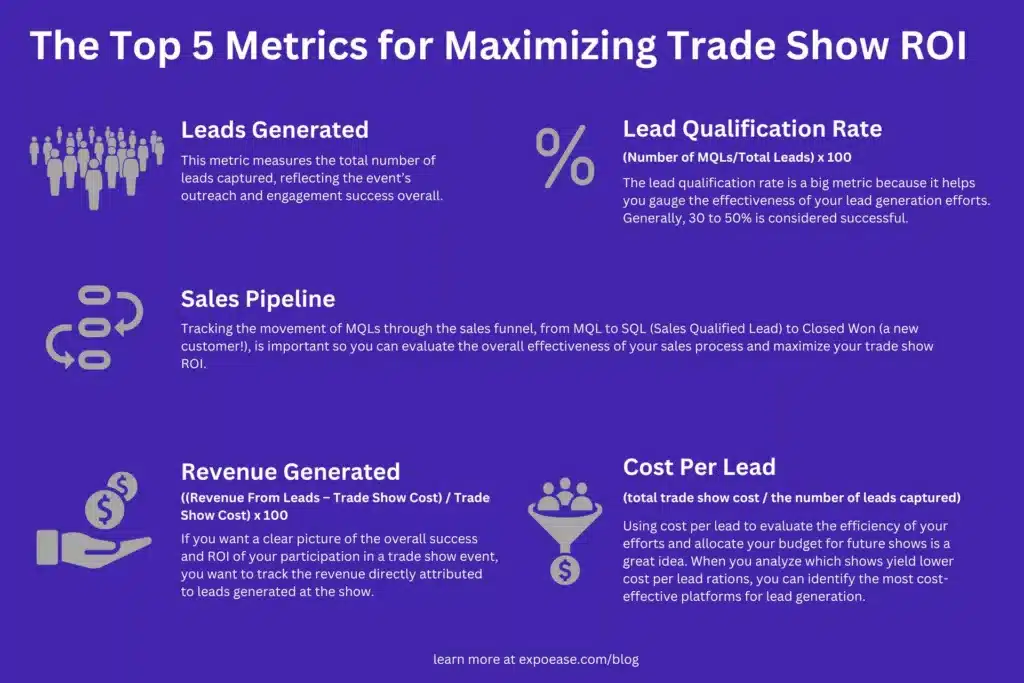Have you been thinking about participating in more trade shows to get your business the increased visibility it needs?
According to EventsWOW, the average cost for a trade show booth in 2021 was $100 to $150 or more per square foot of floor space. This means that a 10×10 booth will cost your business around $14,000. This doesn’t include the costs associated with everything else. For that reason, it is said that you should have approximately three times the amount you plan to spend.
So, determining your trade show ROI is absolutely essential for the success of your trade show event. Identifying key performance indicators (KPIs) help you make more informed decisions for future events so you can see if the initial costs are worth it in the end.
Setting SMART goals ahead of your trade show event is crucial for so many reasons, including clarity and focus, measurability, setting realistic expectations, giving clear deadlines for achievements, ensuring efficiency and proper resource allocation, and they are adaptable.

Key Metrics for Evaluating Trade Show ROI
Let’s dive right into the important metrics that are essential for evaluating the success and return on investment (ROI) of your trade show participation.
1. Leads Generated
The cornerstone of any trade show ROI assessment is really going to be the number of leads generated. With that being said, it is also important to emphasize the distinction between Marketing Qualified Leads (MQLs) and Unqualified Leads. MQLs represent prospects that show genuine interest and potential for conversion, while unqualified leads lack the readiness or relevance for immediate sales engagement.
The leads generated serve as one of the main indicators of trade show effectiveness. This metric measures the total number of leads captured, reflecting the event’s outreach and engagement success overall. This gives you a much greater understanding of potential customers and serves as the basis for future analysis and qualification.
2. Lead Qualification Rate
The formula for the lead qualification rate is (Number of MQLs/Total Leads) x 100.
The lead qualification rate is a big metric because it helps you gauge the effectiveness of your lead generation efforts. Calculate by dividing the number of MQLs by the total number of leads captured and multiply this by 100, as you can see in the formula above. This rate gives you tons of great insight into the quality of leads generated at the trade show event.
A high rate helps ensure a more efficient sales follow-up process. Generally, 30 to 50% is considered successful. This means that a big portion of the leads generated met the criteria and are more likely to convert into customers. Anything above 50% suggests a highly effective lead generation and indicates a large portion of the leads generated were high quality and have the strong potential of turning into customers.
Anything below 30% indicates there is definitely some room for improvement but doesn’t mean it was necessarily a failure. It really depends on the industry and your business goals.
When you focus on qualified leads, your sales team can prioritize their efforts and concentrate on those prospects that have a higher likelihood of driving revenue for your business. A lower rate of under 30% can also sometimes be acceptable as long as the leads generated are highly qualified and likely to convert into customers.
3. Sales Pipeline
Tracking the movement of MQLs through the sales funnel, from MQL to SQL (Sales Qualified Lead) to Closed Won (a new customer!), is important so you can evaluate the overall effectiveness of your sales process and maximize your trade show ROI.
A Marketing Qualified Lead (MQL) refers to a prospective customer who has shown interest. This means they are more likely to become a customer compared to other leads. They are usually ready for further engagement and nurturing to move them further down the sales funnel.
A Sales Qualified Lead is a prospective customer highly likely to make a purchase. Unlike MQLs, SQLs have progressed further down the sales funnel and are ready for more direct sales engagement.
Closed Won refers to a stage in the sales process where the sale opportunity is successfully converted into a sale. It is a successful outcome for the sales team and the customer then moves into the post-sale or customer success phase.
Understanding the conversion rate from leads to sales provides valuable insights when it comes to the efficiency and effectiveness of sales efforts. It allows you to assess the performance of your sales team and how effective they are at nurturing and closing leads acquired from the trade show.
When you track the conversion rate, you identify areas in which you can improve your efforts. This means you can refine your strategies, allocate your resources more effectively, and implement more targeted actions that boost your conversion rates and drive more revenue.

4. Cost Per Lead
Calculating the cost per lead involves dividing the total trade show expenditure by the number of leads you captured during the event. This metric gives you more insight into the efficiency of your lead generation efforts and the way in which you used your resources at the trade show.
The cost per lead formula is the total trade show cost / the number of leads captured. Using cost per lead to evaluate the efficiency of your efforts and allocate your budget for future shows is a great idea. When you analyze which shows yield lower cost per lead rations, you can identify the most cost-effective platforms for lead generation.
It also helps with your ROI analysis. If the cost per lead is higher than the expected value of a lead, it is an indication that the event may not have yielded satisfactory returns. On the other hand, a lower cost per lead could also suggest better efficiency and a higher ROI.
When it comes to budget allocation, the cost per lead allows you to make more informed decisions about the money you set aside for future shows. Allocating resources with lower cost per lead ratios can maximize the effectiveness of your marketing budget.
5. Revenue Generated
If you want a clear picture of the overall success and ROI of your participation in a trade show event, you want to track the revenue directly attributed to leads generated at the show. When calculating ROI using revenue generated minus trade show cost, use this formula:
((Revenue From Leads – Trade Show Cost) / Trade Show Cost) x 100
This formula allows you to quantify the ROI from the trade show by subtracting the total trade show costs from the revenue generated through those leads. It gives you a better understanding of the financial impact of your trade show efforts.
A positive ROI shows you that the revenue generated from the leads exceeds the cost of your participation. This is a profitable outcome. A negative ROI, however, shows you that the investment you made in the trade show event didn’t yield enough revenue to cover the total costs.
Beyond the Numbers: Additional ROI Considerations
Brand Awareness
Tracking your social media engagement during and after an event provides more valuable insights into the reach and impact you have. Analyze metrics that include likes, shares, comments, and hashtag use to gauge audience engagement and identify content that better resonates with your target audience.
Media mention monitoring and brand sentiment also help show you the effectiveness of your brand messaging. Positive mentions and sentiments indicate successful brand positioning and increased awareness.
Customer Feedback
Surveys are another great way to gauge the experience each attendee had at your booth. It gives you some firsthand insight into the effectiveness of your presentations and interactions. You can also gather data on the booth design, staff interactions, and overall satisfaction levels. This helps you improve future engagement, satisfaction, and brand engagement.
Putting it All Together
Measuring trade show ROI is important for you to maximize the impact of your marketing investments and drive more sustainable growth. When you quantify the return on investment from trade show participation, you can also gain valuable insights into the effectiveness of your strategies.
Setting SMART goals and using that data can help measure performance and identify areas for more optimization. This means you can refine your trade show strategies, enhance efficiency, and maximize ROI.
So, when creating your own trade show ROI template, the metrics you want to track are the leads generated, the lead qualification rate, the sales pipeline, the cost per lead, and the revenue generated. However, you can always customize your own trade show ROI template based on your trade show objectives, metrics, and reporting needs.
Ready to find more ways to maximize your presence at a trade show? Contact Expo Ease to discuss photo and videography for media content to extend the value of the show after it ends.
